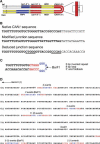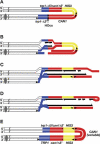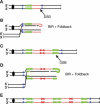A mechanism of palindromic gene amplification in Saccharomyces cerevisiae
- PMID: 15937224
- PMCID: PMC1142561
- DOI: 10.1101/gad.1315805
A mechanism of palindromic gene amplification in Saccharomyces cerevisiae
Abstract
Selective gene amplification is associated with normal development, neoplasia, and drug resistance. One class of amplification events results in large arrays of inverted repeats that are often complex in structure, thus providing little information about their genesis. We made a recombination substrate in Saccharomyces cerevisiae that frequently generates palindromic duplications to repair a site-specific double-strand break in strains deleted for the SAE2 gene. The resulting palindromes are stable in sae2Delta cells, but unstable in wild-type cells. We previously proposed that the palindromes are formed by invasion and break-induced replication, followed by an unknown end joining mechanism. Here we demonstrate that palindrome formation can occur in the absence of RAD50, YKU70, and LIG4, indicating that palindrome formation defines a new class of nonhomologous end joining events. Sequence data from 24 independent palindromic duplication junctions suggest that the duplication mechanism utilizes extremely short (4-6 bp), closely spaced (2-9 bp), inverted repeats to prime DNA synthesis via an intramolecular foldback of a 3' end. In view of our data, we present a foldback priming model for how a single copy sequence is duplicated to generate a palindrome.
Figures





Similar articles
-
Mre11-Sae2 and RPA Collaborate to Prevent Palindromic Gene Amplification.Mol Cell. 2015 Nov 5;60(3):500-8. doi: 10.1016/j.molcel.2015.09.027. Mol Cell. 2015. PMID: 26545079 Free PMC article.
-
Formation of large palindromic DNA by homologous recombination of short inverted repeat sequences in Saccharomyces cerevisiae.Genetics. 2002 Jul;161(3):1065-75. doi: 10.1093/genetics/161.3.1065. Genetics. 2002. PMID: 12136011 Free PMC article.
-
Induction of large DNA palindrome formation in yeast: implications for gene amplification and genome stability in eukaryotes.Cell. 1996 Dec 13;87(6):1115-22. doi: 10.1016/s0092-8674(00)81805-x. Cell. 1996. PMID: 8978615
-
Palindromes in DNA-A Risk for Genome Stability and Implications in Cancer.Int J Mol Sci. 2021 Mar 11;22(6):2840. doi: 10.3390/ijms22062840. Int J Mol Sci. 2021. PMID: 33799581 Free PMC article. Review.
-
A unifying model that explains the origins of human inverted copy number variants.PLoS Genet. 2024 Jan 4;20(1):e1011091. doi: 10.1371/journal.pgen.1011091. eCollection 2024 Jan. PLoS Genet. 2024. PMID: 38175827 Free PMC article. Review.
Cited by
-
Inverted DNA repeats channel repair of distant double-strand breaks into chromatid fusions and chromosomal rearrangements.Mol Cell Biol. 2007 Apr;27(7):2601-14. doi: 10.1128/MCB.01740-06. Epub 2007 Jan 22. Mol Cell Biol. 2007. PMID: 17242181 Free PMC article.
-
Double-strand breaks induce inverted duplication chromosome rearrangements by a DNA polymerase δ-dependent mechanism.Nat Commun. 2023 Nov 2;14(1):7020. doi: 10.1038/s41467-023-42640-5. Nat Commun. 2023. PMID: 37919272 Free PMC article.
-
Chromosome aberrations resulting from double-strand DNA breaks at a naturally occurring yeast fragile site composed of inverted ty elements are independent of Mre11p and Sae2p.Genetics. 2009 Oct;183(2):423-39, 1SI-26SI. doi: 10.1534/genetics.109.106385. Epub 2009 Jul 27. Genetics. 2009. PMID: 19635935 Free PMC article.
-
E. coli SbcCD and RecA control chromosomal rearrangement induced by an interrupted palindrome.Mol Cell. 2010 Jul 9;39(1):59-70. doi: 10.1016/j.molcel.2010.06.011. Mol Cell. 2010. PMID: 20603075 Free PMC article.
-
Gene copy-number variation in haploid and diploid strains of the yeast Saccharomyces cerevisiae.Genetics. 2013 Mar;193(3):785-801. doi: 10.1534/genetics.112.146522. Epub 2013 Jan 10. Genetics. 2013. PMID: 23307895 Free PMC article.
References
-
- Axelrod D.E., Baggerly, K.A., and Kimmel, M. 1994. Gene amplification by unequal sister chromatid exchange: Probabilistic modeling and analysis of drug resistance data. J. Theor. Biol. 168: 151-159. - PubMed
-
- Boeke J.D., Trueheart, J., Natsoulis, G., and Fink, G.R. 1987. 5-Fluoroorotic acid as a selective agent in yeast molecular genetics. Methods Enzymol. 154: 164-175. - PubMed
Publication types
MeSH terms
Substances
LinkOut - more resources
Full Text Sources
Other Literature Sources
Molecular Biology Databases
Research Materials
Miscellaneous
